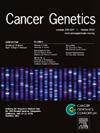24.甲基化测序增强了对克隆造血动态的解读
IF 1.4
4区 医学
Q4 GENETICS & HEREDITY
引用次数: 0
摘要
造血干细胞中的体细胞突变会导致克隆性造血(CH),这是血液恶性肿瘤发生前的一种恶性前状态。在目前的临床实践中,以变异等位基因分数(VAF)量化的CH克隆大小通过DNA测序进行连续监测。VAF 的增加通常被解释为恶性肿瘤进展的预兆。CH会导致髓系偏倚,VAF的测量可能会受到细胞类型比例的影响,而细胞类型比例也会随着免疫需求的变化而变化。我们开发了一种靶向酶法DNA甲基化测序分析方法,成本为80美元/样本(包括试剂、文库制备和测序),可捕获400万个CpGs,并将其应用于91例CH患者样本。我们利用得到的甲基化数据推断细胞类型比例。我们发现,淋巴细胞和粒细胞的预测细胞类型比例与全血细胞计数高度相关(R^2 = 0.84,p 值 = 2.65 × 10^-14;R2 = 0.88,p 值 = 4.31 × 10^-16),但单核细胞的预测比例与全血细胞计数的相关性要低得多(R^2 = 0.26,p 值 = 2.04 × 10^-3)。此外,我们还观察到,随着单核细胞比例的增加,报告的 VAF 百分比变化也在增加。由 TET2 突变驱动的克隆相关性最高,这已被证明具有更极端程度的骨髓偏倚。这项工作引起了人们对目前仅根据 VAF 监测 CH 的方法的担忧。由于成本低廉,通过 DNA 甲基化预测细胞类型比例是对 CH 检测的一种可行补充。我们的工作表明,细胞类型比例将为准确解释整个血液恶性肿瘤进展和治疗过程中的 VAF 提供重要依据。本文章由计算机程序翻译,如有差异,请以英文原文为准。
24. Methylation sequencing enhances interpretation of clonal hematopoiesis dynamics
Somatic mutations in hematopoietic stem cells give rise to clonal hematopoiesis (CH), a pre-malignant state that precedes hematologic malignancy. In current clinical practice, CH clone size as quantified by the variant allele fraction (VAF) is serially monitored with DNA sequencing. Increases in VAF are often interpreted as portending progression to malignancy. CH leads to a myeloid bias and VAF measurements can be confounded by cell-type proportions, which also vary according to immune demands. We developed a targeted enzymatic DNA methylation sequencing assay that costs ∼$80/sample (including reagents, library preparation and sequencing) and captures ∼4 million CpGs and applied it to 91 samples from patients with CH. We used the resulting methylation data to infer cell-type proportions. We found that predicted cell-type proportions for lymphocytes and granulocytes correlated highly with complete blood cell counts (R^2 = 0.84 and p-value = 2.65 × 10^-14; R2 = 0.88 and p-value = 4.31 × 10^-16), but predictions for monocytes were much less correlated (R^2 = 0.26, p-value = 2.04 × 10^-3). Furthermore, we observed that as monocyte proportion increased, so did reported percent change in VAF. Correlation was highest for clones driven by mutations in TET2, which have been shown to have more extreme degrees of myeloid bias. This work raises concerns about current methods of monitoring CH based solely on VAF. Given the low cost, cell-type proportion prediction from DNA methylation is a feasible addition to CH assays. Our work suggests that cell-type proportions would provide vital context for accurate interpretation of VAF throughout hematologic malignancy progression and treatment.
求助全文
通过发布文献求助,成功后即可免费获取论文全文。
去求助
来源期刊

Cancer Genetics
ONCOLOGY-GENETICS & HEREDITY
CiteScore
3.20
自引率
5.30%
发文量
167
审稿时长
27 days
期刊介绍:
The aim of Cancer Genetics is to publish high quality scientific papers on the cellular, genetic and molecular aspects of cancer, including cancer predisposition and clinical diagnostic applications. Specific areas of interest include descriptions of new chromosomal, molecular or epigenetic alterations in benign and malignant diseases; novel laboratory approaches for identification and characterization of chromosomal rearrangements or genomic alterations in cancer cells; correlation of genetic changes with pathology and clinical presentation; and the molecular genetics of cancer predisposition. To reach a basic science and clinical multidisciplinary audience, we welcome original full-length articles, reviews, meeting summaries, brief reports, and letters to the editor.
 求助内容:
求助内容: 应助结果提醒方式:
应助结果提醒方式:


